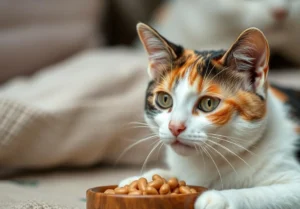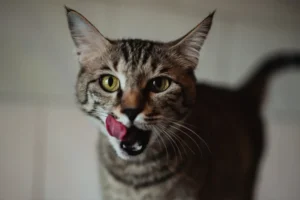Cats are known for being picky eaters, turning up their noses at certain foods that other pets might devour without hesitation. One such food is ham, a popular choice for many pet owners looking to give their feline friends a treat. But have you ever wondered why cats can’t have ham?
Cats Lack the Necessary Enzymes to Digest Ham
Lack of Enzymes in Cat’s Digestive System
Hey there, feline friends! Let’s chat about why your kitty can’t indulge in that delicious ham you’re enjoying. It turns out that cats lack the specific enzymes needed to break down and digest ham effectively.
You see, ham contains high levels of salt and fat that require enzymes like amylase and maltase to properly process. Unfortunately, our whiskered pals don’t produce enough of these enzymes to tackle the ham feast. So, when cats nibble on ham, it can lead to digestive discomfort and even more serious health issues.
But fear not, there are plenty of yummy cat-friendly treats out there that won’t upset your furball’s tummy. Opt for specialized cat treats or lean meats like cooked chicken for a safer and happier kitty. Your feline friend will thank you for it!
Potential Digestive Issues
Now, let’s dig a little deeper into why serving ham to your cat is a no-go. Feeding your kitty ham can bring about a host of digestive issues that you definitely want to avoid.
Ham is high in fat and salt, which can be too much for your cat’s sensitive stomach to handle. This can lead to upset stomach, diarrhea, vomiting, and even more severe problems like pancreatitis. Nobody wants to see their furry friend in discomfort, so it’s best to steer clear of sharing your ham sandwich with them.
To keep your cat healthy and happy, ensure they stick to their regular diet and plenty of fresh water. Avoid giving in to those pleading eyes when you’re enjoying ham – your cat will be better off without it.
Health Risks of Feeding Cats Ham
Feeding your feline friend ham may seem harmless, but it can pose serious health risks. High sodium content in ham can lead to dehydration and high blood pressure in cats. Additionally, some cats may have allergies to the preservatives and seasonings commonly found in ham, leading to digestive issues or skin problems. Remember, a little nibble of ham may seem harmless to us, but it can have negative consequences for our furry companions.
Alternative Treat Options
Instead of ham, consider safer and healthier treat options for your cat. Opt for small pieces of cooked chicken or turkey as a tasty and protein-rich alternative. You can also offer freeze-dried meat treats specifically made for cats, ensuring they get a delicious snack without any harmful additives. Remember, it’s important to prioritize your cat’s health and well-being when choosing their treats.
Alternative Treat Options:
– Salmon: Rich in omega-3 fatty acids, this fish is not only delicious but also beneficial for your cat’s skin and coat.
– Catnip: A natural treat that many cats enjoy, providing mental stimulation and playtime fun.
– Green beans: Surprisingly, some cats enjoy this crunchy vegetable as a low-calorie snack.
– Plain cooked pasta: A small amount can be a safe and satisfying treat for your cat.
– Cat grass: Perfect for indoor cats to aid digestion and prevent hairballs.
Remember, a balanced diet is key to keeping your cat healthy and happy. Choose treats that are specifically formulated for feline dietary needs to avoid any potential health issues.
Dietary Needs of Cats
Cats are obligate carnivores, which means their diet should consist primarily of meat. While ham might seem like a tasty treat for your feline friend, it is not an ideal choice for several reasons. Ham is high in salt and fat, which can be harmful to cats and may lead to health issues such as obesity, heart problems, and pancreatitis. Additionally, ham is processed and often seasoned with ingredients like garlic and onion, which are toxic to cats. It’s best to stick to a diet that is specially formulated for cats to ensure they get all the nutrients they need to stay healthy and happy.
Homemade Cat Treat Recipes
If you’re looking for safe and enjoyable treat options for your cat, consider making homemade treats using cat-friendly ingredients. Here are some simple recipes you can try:
- Tuna Treats – Mix canned tuna with a bit of water and flour to form a dough. Roll the dough into small balls and bake until crispy.
- Chicken Crunchies – Cook chicken breast, then shred and mix with a bit of catnip and flour. Shape into small pieces and bake until crunchy.
- Pumpkin Poppers – Combine canned pumpkin puree with oat flour and a dash of catnip. Form small balls and bake until firm.
These homemade treats are a great way to bond with your cat and provide them with tasty snacks that are safe and healthy. Remember to offer treats in moderation to keep your cat’s diet balanced and their weight in check.
Importance of Consulting a Vet
Before giving your cat any new food, like ham, it’s crucial to consult a vet. Veterinarians are experts when it comes to feline nutrition, and they can provide you with tailored advice on what foods are safe for your furball. Every cat is unique, and what works for one may not work for another. So, reach out to your vet before introducing any new treats to your cat’s diet.
Fun Facts about Cat Digestive System
Did you know that cats are obligate carnivores, which means their digestive systems are specially designed to digest meat? Unlike omnivores like humans, cats require a diet that is high in animal protein to stay healthy. Their digestive tracts are short and efficient at processing animal-based foods, making it difficult for them to digest other types of food, like ham. Ensure you’re feeding your feline friend a diet that aligns with their unique digestive needs to keep them happy and healthy.
By understanding why cats can’t have ham, you can ensure that your feline friend stays happy and healthy without missing out on delicious snacks.
Alex, a passionate animal lover, has experience in training and understanding animal behavior. As a proud pet parent to two dogs and three cats, he founded AnimalReport.net to share insights from animal experts and expand his knowledge of the animal kingdom.




